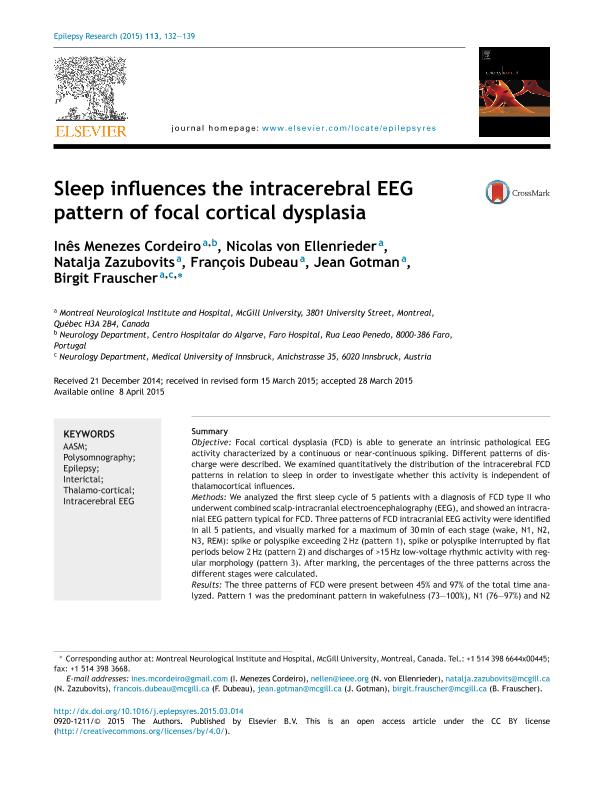Mostrar el registro sencillo del ítem
dc.contributor.author
Menezes Cordeiro, Inês
dc.contributor.author
Von Ellenrieder, Nicolás

dc.contributor.author
Zazubovits, Natalja
dc.contributor.author
Dubeau, François
dc.contributor.author
Gotman, Jean
dc.contributor.author
Frauscher, Birgit
dc.date.available
2018-07-30T16:24:55Z
dc.date.issued
2015-07
dc.identifier.citation
Menezes Cordeiro, Inês; Von Ellenrieder, Nicolás; Zazubovits, Natalja; Dubeau, François; Gotman, Jean; et al.; Sleep influences the intracerebral EEG pattern of focal cortical dysplasia; Elsevier Science; Epilepsy Research; 113; 7-2015; 132-139
dc.identifier.issn
0920-1211
dc.identifier.uri
http://hdl.handle.net/11336/53399
dc.description.abstract
We analyze the distribution of intracerebral EEG patterns of FCD in relation to sleep. FCD interictal EEG patterns are present between 45% and 97% of the time analyzed. Despite almost continuous spiking, sleep is an important modulator of FCD EEG patterns. This suggests that dysplastic tissue is under thalamocortical control. Objective: Focal cortical dysplasia (FCD) is able to generate an intrinsic pathological EEG activity characterized by a continuous or near-continuous spiking. Different patterns of discharge were described. We examined quantitatively the distribution of the intracerebral FCD patterns in relation to sleep in order to investigate whether this activity is independent of thalamocortical influences. Methods: We analyzed the first sleep cycle of 5 patients with a diagnosis of FCD type II who underwent combined scalp-intracranial electroencephalography (EEG), and showed an intracranial EEG pattern typical for FCD. Three patterns of FCD intracranial EEG activity were identified in all 5 patients, and visually marked for a maximum of 30. min of each stage (wake, N1, N2, N3, REM): spike or polyspike exceeding 2. Hz (pattern 1), spike or polyspike interrupted by flat periods below 2. Hz (pattern 2) and discharges of >15. Hz low-voltage rhythmic activity with regular morphology (pattern 3). After marking, the percentages of the three patterns across the different stages were calculated. Results: The three patterns of FCD were present between 45% and 97% of the total time analyzed. Pattern 1 was the predominant pattern in wakefulness (73-100%), N1 (76-97%) and N2 (58-88.5%) in all patients, and in REM in 4 of 5 patients (91-100%). During N2 and N3, there was an increase in pattern 2 in all patients, becoming the predominant pattern in 3 of the 5 patients during N3 (63-89%). Pattern 3 was rare and only sporadically observed during N2 and N3. Wakefulness and REM sleep showed a similar pattern (pattern 1) with a slight amplitude reduction in REM sleep. Significance: Despite the presence of an almost continuous discharge, sleep is an important modulator of the pathological EEG patterns found in FCD type II. This might suggest that dysplastic tissue is influenced by the thalamo-cortical control mechanisms involved in the generation of sleep.
dc.format
application/pdf
dc.language.iso
eng
dc.publisher
Elsevier Science

dc.rights
info:eu-repo/semantics/openAccess
dc.rights.uri
https://creativecommons.org/licenses/by-nc-sa/2.5/ar/
dc.subject
Aasm
dc.subject
Epilepsy
dc.subject
Interictal
dc.subject
Intracerebral Eeg
dc.subject
Polysomnography
dc.subject
Thalamo-Cortical
dc.subject.classification
Inmunología

dc.subject.classification
Medicina Básica

dc.subject.classification
CIENCIAS MÉDICAS Y DE LA SALUD

dc.title
Sleep influences the intracerebral EEG pattern of focal cortical dysplasia
dc.type
info:eu-repo/semantics/article
dc.type
info:ar-repo/semantics/artículo
dc.type
info:eu-repo/semantics/publishedVersion
dc.date.updated
2018-07-30T13:34:47Z
dc.journal.volume
113
dc.journal.pagination
132-139
dc.journal.pais
Países Bajos

dc.journal.ciudad
Amsterdam
dc.description.fil
Fil: Menezes Cordeiro, Inês. McGill University; Canadá. Faro Hospital; Portugal
dc.description.fil
Fil: Von Ellenrieder, Nicolás. Consejo Nacional de Investigaciones Científicas y Técnicas; Argentina. McGill University; Canadá
dc.description.fil
Fil: Zazubovits, Natalja. McGill University; Canadá
dc.description.fil
Fil: Dubeau, François. McGill University; Canadá
dc.description.fil
Fil: Gotman, Jean. McGill University; Canadá
dc.description.fil
Fil: Frauscher, Birgit. McGill University; Canadá. Universidad de Innsbruck; Austria
dc.journal.title
Epilepsy Research

dc.relation.alternativeid
info:eu-repo/semantics/altIdentifier/doi/https://dx.doi.org/10.1016/j.eplepsyres.2015.03.014
dc.relation.alternativeid
info:eu-repo/semantics/altIdentifier/url/https://www.sciencedirect.com/science/article/pii/S0920121115000698
Archivos asociados
